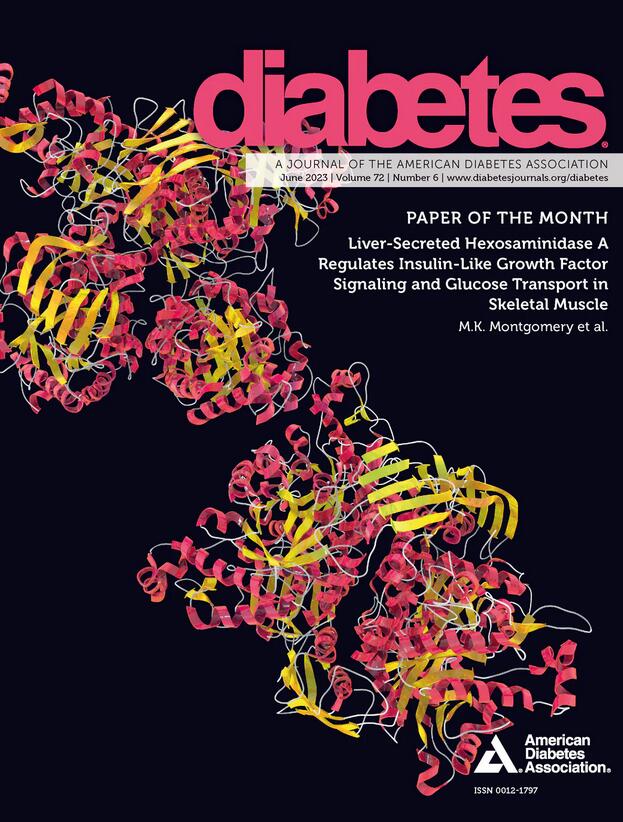DNA甲基化生物标志物预测妊娠期高血糖母亲的后代代谢风险
IF 7.5
1区 医学
Q1 ENDOCRINOLOGY & METABOLISM
引用次数: 0
摘要
妊娠期糖尿病影响着全世界近1800万名孕妇,并且还在逐年增加。在过去的20年里增长了70%。DNA甲基化与母亲高血糖和后代2型糖尿病风险相关。本研究假设怀孕期间的高血糖会影响出生时介导后代代谢风险的DNA甲基化变化。脐带血样本(n = 112)来自参加香港高血糖和不良妊娠结局研究中心的糖耐量正常(n = 43)、糖耐量受损(n = 31)和糖耐量低(n = 38)的妇女。差异甲基化区(DMRs)通过甲基化测序鉴定,并评估其与后代代谢功能障碍的关系。受试者工作特征曲线分析评估DMRs对产妇血糖状态分类的预测价值。这些DMRs在人β细胞和胰腺导管上皮细胞对高血糖刺激的反应中进行了评估。甲基化测序鉴定出脐带血中19个与母体高血糖相关的甲基化生物标志物,这些标志物与后代代谢异常相关。结合19个DMRs改善了对7,11和18岁后代β细胞功能障碍的预测,从单独使用临床因素的曲线下面积(AUC)评分范围从0.53到0.68到AUC评分范围从0.71到0.95。人类细胞模型验证证实,高血糖影响甲基化依赖性基因表达。这项研究表明,脐带血中的DNA甲基化生物标志物可以预测后代的代谢功能障碍,突出了它们作为糖尿病风险早期指标的潜力。这些发现与人类胰腺细胞中甲基化介导的调节一致。母亲高血糖与19种脐带血DNA甲基化生物标志物有关,这些生物标志物可预测后代代谢功能障碍。与单独的临床因素相比,这些甲基化变化与母亲血糖状态相关,改善了7岁、11岁和18岁时β细胞功能障碍的预测。在人β细胞和胰腺导管上皮细胞中的验证证实,高血糖影响甲基化依赖性基因的表达。这些发现强调了出生时表观遗传修饰作为糖尿病风险早期指标的作用,表明子宫内高血糖暴露可能介导后代的长期代谢结果。本文章由计算机程序翻译,如有差异,请以英文原文为准。
DNA Methylation Biomarkers Predict Offspring Metabolic Risk From Mothers With Hyperglycemia in Pregnancy
Gestational diabetes mellitus affects almost 18 million pregnancies worldwide, increasing by >70% in the past 20 years. DNA methylation has been associated with maternal hyperglycemia and type 2 diabetes risk in offspring. This study hypothesized that hyperglycemia during pregnancy influences DNA methylation changes at birth that mediate metabolic risk in offspring. Cord blood samples (n = 112) were obtained from women with normal (n = 43), impaired (n = 31), and low (n = 38) glucose tolerance enrolled in the Hong Kong field center of the Hyperglycemia and Adverse Pregnancy Outcome (HAPO) study. Differentially methylated regions (DMRs) were identified using methylation sequencing and evaluated for their association with offspring metabolic dysfunction. Receiver operating characteristic curve analysis assessed the predictive value of DMRs for the classification of maternal glycemic status. These DMRs were assessed in human β-cells and pancreatic ductal epithelial cells in response to hyperglycemic stimuli. Methylation sequencing identified 19 methylation biomarkers in cord blood associated with maternal hyperglycemia, which correlated with offspring metabolic abnormalities. Incorporating the 19 DMRs improved the prediction of offspring β-cell dysfunction at 7, 11, and 18 years of age from area under the curve (AUC) scores ranging from 0.53 to 0.68 using clinical factors alone to AUC scores ranging from 0.71 to 0.95. Validation in human cell models confirmed that hyperglycemia influences methylation-dependent gene expression. This study demonstrates that DNA methylation biomarkers in cord blood predict offspring metabolic dysfunction, highlighting their potential as early indicators of diabetes risk. The findings align with methylation-mediated regulation in human pancreatic cells. ARTICLE HIGHLIGHTS Maternal hyperglycemia is linked to 19 cord blood DNA methylation biomarkers that predict offspring metabolic dysfunction. These methylation changes, associated with maternal glycemic status, improved the prediction of β-cell dysfunction at 7, 11, and 18 years of age compared with clinical factors alone. Validation in human β-cells and pancreatic ductal epithelial cells confirmed that hyperglycemia influences methylation-dependent gene expression. These findings highlight the role of epigenetic modifications at birth as early indicators of diabetes risk, suggesting that in utero hyperglycemic exposure may mediate long-term metabolic outcomes in offspring.
求助全文
通过发布文献求助,成功后即可免费获取论文全文。
去求助
来源期刊

Diabetes
医学-内分泌学与代谢
CiteScore
12.50
自引率
2.60%
发文量
1968
审稿时长
1 months
期刊介绍:
Diabetes is a scientific journal that publishes original research exploring the physiological and pathophysiological aspects of diabetes mellitus. We encourage submissions of manuscripts pertaining to laboratory, animal, or human research, covering a wide range of topics. Our primary focus is on investigative reports investigating various aspects such as the development and progression of diabetes, along with its associated complications. We also welcome studies delving into normal and pathological pancreatic islet function and intermediary metabolism, as well as exploring the mechanisms of drug and hormone action from a pharmacological perspective. Additionally, we encourage submissions that delve into the biochemical and molecular aspects of both normal and abnormal biological processes.
However, it is important to note that we do not publish studies relating to diabetes education or the application of accepted therapeutic and diagnostic approaches to patients with diabetes mellitus. Our aim is to provide a platform for research that contributes to advancing our understanding of the underlying mechanisms and processes of diabetes.
 求助内容:
求助内容: 应助结果提醒方式:
应助结果提醒方式:


